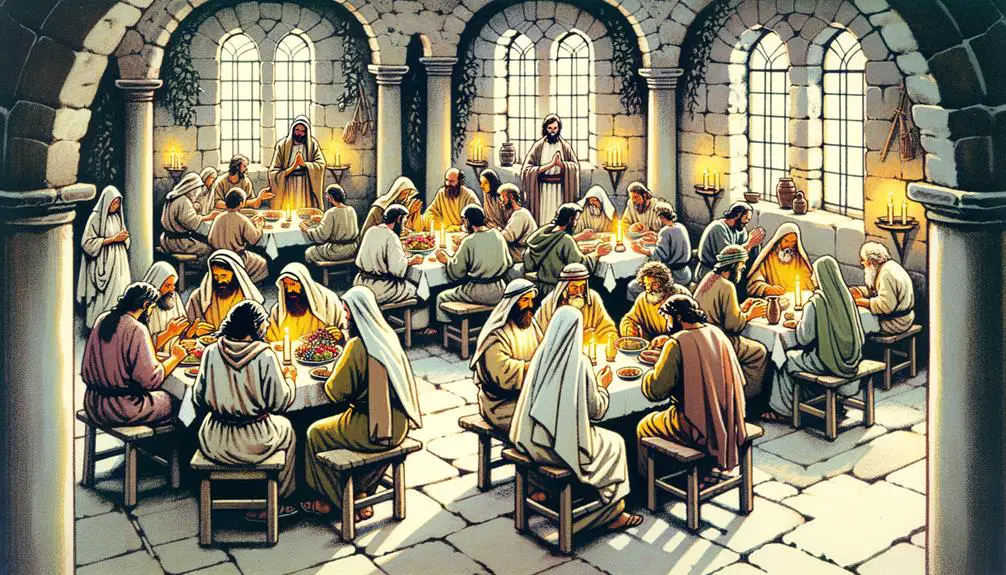Highlighting the Bible's emphasis on collaboration, discover how unity shapes pivotal moments and offers lessons on collective strength.

Working Together in the Bible
In the Good Book, the art of collaboration is not just encouraged; it's a cornerstone of many pivotal moments. You'll find that from the initial days of creation to the intricate construction of the Tabernacle, the spirit of working together weaves through the narratives.
Consider the unity in building Noah's Ark or the early church's growth in Acts—each story underscoring the power of collective effort in the face of monumental tasks. These episodes are not just historical footnotes; they offer timeless wisdom on the strength found in unity.
Let's explore how these lessons can still resonate within your own community and beyond.
Key Takeaways
- The Bible highlights the importance of collaboration, as seen in Noah's Ark construction and Nehemiah's community efforts.
- Unity and mutual support were foundational in the early church, emphasizing material equality and shared mission.
- Spiritual well-being and church dynamics rely on diverse gifts, unity, and effective conflict resolution to reflect Christ's love.
- Collective responsibility and divine mandates in Scripture underscore the value of working together to embody the Gospel and demonstrate God's nature.
The Creation of Humanity

In the biblical narrative, God purposefully created humanity in His own image, establishing a fundamental basis for collaboration and community among people. This divine act imbues human nature with inherent dignity and calls for mutual respect and cooperation among individuals. You're invited to ponder the ethical implications of this creation story, which underscores the importance of working together in harmony.
Human nature, as depicted in this account, isn't solitary; it thrives on connection and collaboration. The ethical implications of being made 'in the image of God' extend beyond personal morality to include how you interact with others. This foundation suggests that collaboration isn't just beneficial—it's a divine mandate, reflecting the communal nature of the Creator Himself.
You're encouraged to see this narrative as a call to action, prompting a reevaluation of how you engage with others in your community and beyond. The biblical emphasis on collaboration and community challenges you to look beyond individualistic pursuits and consider the collective good.
Understanding human nature through this lens also presses you to confront and address the often overlooked ethical implications of isolation and selfishness. It's a reminder that your actions and inactions have a profound impact on the fabric of community life.
The creation story, therefore, isn't just an account of the origins of humanity; it's a blueprint for living together in a manner that honors the divine image within each person. It's a call to forge connections, bridge divides, and work collaboratively towards a more just and compassionate world.
Building Noah's Ark
You'll find that the building of Noah's Ark, as narrated in the Bible, wasn't just about obeying a divine command; it was a comprehensive test of faith, resourcefulness, and cooperation.
Gathering materials and animals required unprecedented logistics and faith in God's provision, while facing the construction challenges of the Ark demanded ingenuity and perseverance.
This narrative invites you to explore how faith, obedience, and communal effort are intertwined in accomplishing God's will.
Divine Command to Noah
God directly commanded Noah to build an ark, a divine mandate that not only tested his faith but also his willingness to cooperate with an unseen plan. This command wasn't arbitrary; it was a crucial step towards fulfilling a larger, divine purpose.
The construction of the ark symbolized Noah's unwavering faith and obedience. By following God's instructions, Noah played a pivotal role in the preservation of the human race and the animal kingdom.
The subsequent rainbow covenant established between God and Noah signified a promise of never again destroying the earth with a flood, highlighting the importance of obedience and collaboration with the divine.
The directive to bring animal pairs into the ark underscored the significance of preserving life in its entirety, demonstrating a divine foresight and care for all creation.
Gathering Materials and Animals
Following the divine command to Noah, the next critical step involved meticulously gathering materials and animals for the construction of the ark, a process that demanded both faith and precision in execution. This stage underscores early instances of animal domestication, as Noah faced the monumental task of assembling a diverse range of species in pairs. The endeavor not only showcased his unwavering obedience but also highlighted his understanding of animal behavior and needs, essential for their survival and care aboard the ark.
Concurrently, material scarcity posed a significant challenge. Securing sufficient wood and other necessary resources in a pre-industrial world required innovative approaches and divine guidance. This phase of preparation illustrates a harmonious blend of divine instruction, human endeavor, and natural resource management, setting a foundation for the subsequent construction challenges.
Ark's Construction Challenges
Upon gathering the necessary materials and animals, Noah faced the formidable task of constructing the ark, a feat that required not only divine guidance but also an unparalleled understanding of craftsmanship and engineering. This endeavor demanded a deep comprehension of:
- Ancient shipbuilding techniques to ensure seaworthiness
- Resource management to minimize environmental impact
- Structural design to accommodate a vast array of species
- Logistics for storing provisions for all aboard
- Coordination among helpers to efficiently execute the divine blueprint
These challenges underscore the complexity of the ark's construction, highlighting Noah's reliance on divine wisdom and his innovative application of ancient shipbuilding methods.
This process not only demonstrated an exceptional feat of engineering but also a profound respect for the environment, ensuring the survival of the natural world through careful planning and execution.
Constructing the Tabernacle
As you explore the construction of the Tabernacle, you'll discover that unity in craftsmanship was pivotal, reflecting a harmonized effort under divine guidance. God's detailed design instructions underscored the importance of adhering to a celestial blueprint, ensuring the sacred space mirrored heavenly standards.
Moreover, the community's voluntary offerings demonstrated a collective commitment to God's dwelling among them, highlighting the profound spiritual significance of their contributions.
Unity in Craftsmanship
In constructing the Tabernacle, the Israelites came together, showcasing a profound unity in craftsmanship, guided by divine instructions and a shared spiritual purpose. This exemplifies how artisan collaboration and cooperative projects are crucial in achieving monumental tasks that are beyond individual capabilities.
- Shared Vision: Everyone worked towards a common goal, enhancing the project's coherence.
- Diverse Skills: Each person's unique abilities contributed to different aspects of the construction.
- Mutual Respect: Acknowledgment of each other's craftsmanship fostered a respectful working environment.
- Coordinated Effort: Tasks were distributed efficiently, ensuring timely completion.
- Spiritual Connection: The collective endeavor wasn't just about building a physical structure but also about reinforcing their spiritual bond.
These elements underscore the importance of unity in executing large-scale, meaningful projects.
Divine Design Instructions
Throughout the construction of the Tabernacle, God meticulously provided the Israelites with divine design instructions, ensuring that every detail reflected His glory and purpose. These directives weren't arbitrary; each served a significant function in establishing a sacred space where the divine and human could commune.
The sanctuary layout, prescribed in intricate detail, facilitated a harmonious flow for worship and underscored the gravity of God's presence among His people. Similarly, worship protocols were carefully outlined, not only to maintain reverence but also to illustrate deeper spiritual truths about holiness, atonement, and the covenant relationship between God and Israel.
This divine blueprint wasn't just about constructing a physical structure; it was a profound exercise in obedience, faith, and understanding the character of God through the tangible elements of worship and community life.
Community Offering Contributions
Shifting focus to the communal effort in constructing the Tabernacle, believers united in offering contributions, a testament to their collective faith and dedication to God's command. This significant event underscores the importance of:
- Harnessing spiritual gifts for the common good
- Engaging in communal prayer to seek guidance and blessing
- Volunteering skills and resources freely
- Fostering a sense of unity and purpose among the community
- Recognizing the diversity of contributions as equally valuable
This collaborative endeavor not only facilitated the physical construction of the Tabernacle but also reinforced the spiritual bonds within the community. By pooling their resources and talents, they demonstrated a profound understanding of stewardship and shared responsibility in fulfilling God's mandate, setting a timeless example for future generations on the power of working together in faith.
Nehemiah Rebuilds the Walls
Nehemiah's determination to rebuild Jerusalem's walls serves as a profound testament to collaborative faith and perseverance in the face of adversity. This episode, rich in leadership lessons and community resilience, unfolds in a narrative that not only highlights the physical rebuilding of a city but also the spiritual fortification of a people. Nehemiah's role transcends that of a mere builder; he embodies the quintessence of a visionary leader who, through prayer and practical action, mobilizes a community towards a common goal.
Analyzing Nehemiah's approach offers invaluable insights into effective leadership within a faith context. Firstly, his initial response to the news of Jerusalem's desolation is one of deep empathy and prayer, demonstrating that spiritual readiness is the foundation of any significant endeavor. This spiritual anchoring is what guides the community's resilience, as they face not only the physical task of rebuilding but also opposition from adversaries.
Furthermore, Nehemiah's strategy to assign specific sections of the wall to different families and groups illustrates an acute understanding of community dynamics. This approach not only expedites the construction process but also instills a sense of ownership and responsibility among the participants, reinforcing community bonds. It's a vivid illustration of how shared challenges can unite individuals, fostering a resilient community that can withstand external pressures.
In essence, Nehemiah's story is a masterclass in harnessing faith, leadership, and communal effort to overcome adversity. It underscores the importance of visionary leadership in rallying a community, the power of collective action in achieving monumental tasks, and the indomitable spirit of resilience that faith communities can exhibit.
The Early Church in Acts

Embracing the spirit of unity and divine purpose, the early Church in Acts demonstrates a transformative model of community that transcends cultural and geographical boundaries. This period, marked by the Pentecost event, saw the birth of a new way of living together, centered around the teachings of Jesus and propelled by the Holy Spirit. You'll find that this era wasn't just about spreading the Gospel; it was also about creating a blueprint for collaborative, faith-driven communities.
The Acts of the Apostles offers numerous accounts of how believers worked together, showcasing the power of collective action underpinned by faith. From the sharing of possessions to the support of apostolic missions, the early Church provides timeless lessons on cooperation and mutual support.
Consider these key aspects of their communal life:
- The Pentecost event catalyzed the formation of the early Church, uniting diverse peoples through the Holy Spirit.
- Common goods sharing emphasized the importance of material equality and mutual support.
- Prayer gatherings reinforced spiritual unity and collective reliance on God's guidance.
- Apostolic missions were supported by the community, illustrating a commitment to spreading the Gospel together.
- Handling conflicts, such as the appointment of the seven in Acts 6, showcased the early Church's wisdom in maintaining unity amidst challenges.
Analyzing the early Church's approach reveals a profound understanding of collaboration, grounded in spiritual conviction and practical action. Their example serves as a compelling blueprint for contemporary communities, emphasizing that working together, guided by faith, can overcome obstacles and spread transformative messages far and wide.
Paul's Letters to the Corinthians
In Paul's letters to the Corinthians, we encounter a profound exploration of unity and division within a Christian community, offering timeless insights into the challenges and opportunities of collective faith practice. These epistles delve into the dynamics of working together, emphasizing the importance of spiritual gifts and church discipline.
Paul's discourse on spiritual gifts in 1 Corinthians chapters 12 through 14 underscores the diversity of gifts bestowed by the Holy Spirit, highlighting that each believer's contribution is vital for the well-being of the church. He argues that while gifts vary, they're all equally important, illustrating the concept that in the body of Christ, no one is insignificant. This perspective encourages you to appreciate and utilize the unique talents and abilities you bring to your faith community, fostering a sense of belonging and purpose.
Moreover, Paul addresses the necessity of church discipline, particularly in 1 Corinthians 5. He presents a scenario where moral integrity within the community is compromised, advocating for corrective measures to restore spiritual health. This teaches you that discipline isn't just punitive but aims at redemption and the maintenance of communal holiness. Through these instructions, Paul conveys that working together involves not only celebrating each other's strengths but also addressing weaknesses with grace and truth.
Paul's letters to the Corinthians thus serve as a crucial guide for navigating the complexities of community life. They remind you that collective faith practice requires a delicate balance between affirming individual contributions and upholding communal standards, ensuring the church remains a place of growth, support, and spiritual vitality.
The Unity of Believers

The concept of unity among believers is a foundational principle woven throughout the fabric of Scripture, emphasizing how individual faith journeys contribute to a collective spiritual purpose. This unity isn't merely a lofty ideal but a practical, living reality that Scripture commands you to pursue. It's crucial in fostering spiritual harmony and effective conflict resolution within the faith community.
- Mutual Edification: Your spiritual growth isn't an isolated event. You're called to build each other up, sharing insights and experiences that enrich the collective faith journey.
- Diverse Gifts, One Body: Just as a body comprises different parts, each believer brings unique gifts to the table. It's in coming together that these gifts synergize, advancing God's kingdom.
- Conflict Resolution: Scripture doesn't shy away from the reality of conflict within communities. Instead, it provides a blueprint for resolution, emphasizing forgiveness, understanding, and reconciliation, all of which are pillars of unity.
- Collective Worship: When you come together in worship, you're not just individuals in the same space. You're a single entity, lifting praises to God. This act itself is a powerful expression of unity.
- Mission and Service: Unified believers are a formidable force in mission and service. Your shared faith compels you to act, reaching out to the world with a message of hope and love.
In essence, the unity of believers is pivotal. It's not just about getting along but about embodying the very essence of the Gospel. Through spiritual harmony and conflict resolution, you mirror Christ's love to each other and the world.
Frequently Asked Questions
How Does the Concept of Working Together in the Bible Relate to Modern Team-Building Theories?
You'll find that ancient strategies and spiritual teamwork from biblical teachings align closely with modern team-building theories. These concepts stress the importance of unity, shared goals, and mutual support—core principles in today's collaborative environments.
Can Principles of Collaboration From the Bible Be Applied in Secular or Non-Religious Organizational Settings?
Absolutely, you can apply biblical collaboration principles in secular or non-religious organizational settings. Even outside religious contexts, the core values of teamwork, mutual respect, and shared goals, rooted in spiritual motivations, are universally applicable.
These principles encourage a cohesive environment, enhancing productivity and innovation. By focusing on common human values rather than specific faith-based origins, you foster a more inclusive and effective team dynamic.
Are There Examples in the Bible Where Working Together Led to Negative Outcomes, and What Lessons Can Be Learned From These Instances?
Yes, the Bible shows cases where teamwork led to negative outcomes. The Tower of Babel is a prime example; their united efforts to build a tower reaching heaven ended in confusion and dispersion.
Achan's Sin, where his actions affected the entire Israelite community, highlights how collective responsibility can turn sour.
These stories teach the importance of aligning collective efforts with moral and ethical standards, rather than merely achieving a common goal.
How Do Biblical Teachings on Working Together Address Issues of Diversity and Inclusion Within a Team?
In addressing issues of diversity and inclusion, biblical teachings emphasize overcoming cultural barriers and valuing individual talents within a team.
You're encouraged to recognize and celebrate differences, understanding that each person's unique abilities contribute to a stronger collective.
This perspective, rooted in faith, guides you to work harmoniously, fostering an environment where everyone's contributions are valued.
It's a lesson in unity, showing how varied talents can lead to greater achievements when working together.
What Role Do Leadership and Hierarchy Play in Biblical Examples of Collaboration, and How Can These Principles Be Adapted to Contemporary Leadership Models?
In your exploration of leadership and hierarchy, you'll find that Divine Authority shapes principles of collaboration.
These biblical frameworks can be adapted to contemporary leadership through the concept of Servant Leadership, emphasizing humility and service to others.
By analyzing these models, you discern how ancient guidance fosters inclusive, effective teams today.
This approach not only aligns with scholarly, faith-based analysis but also enriches modern leadership practices with timeless wisdom.
Conclusion
As we've journeyed through scriptural narratives, from the dawn of humanity to the fellowship of the early church, it's clear that collaboration is divine. Consider the metaphor of the body, as Paul does in 1 Corinthians 12:12—though composed of many parts, it functions as one.
This unity, this coming together to achieve a common purpose, isn't just a strategy but a sacred blueprint. It underscores a profound truth: in unity, we reflect the image of a collaborative God, achieving purposes far beyond our individual capabilities.



Sign up